Contents Of Article
In this article, I will provide information about how to plan a Hampi trip effectively by using my
previous experience of Humpi visits. Hampi is a remarkable travel destination located on the bank of the Tungabhadra River in Karnataka, India, known for its stunning historical remains, rich cultural heritage, and unique landscape.
It was once the capital of the great Vijayanagara Empire and has been a UNESCO World Heritage site since 1986. For anyone who is looking for an adventure that mixes history, spirituality, and architectural beauty, Hampi is the perfect destination.
Why One Should Visit Hampi?
Before I am going to explore the details of how to plan a Hampi trip, it’s important to understand what makes Hampi special:
1. It’s Historical Significance
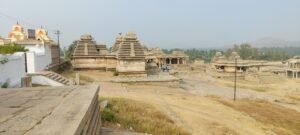
Hampi was the capital of the Vijayanagara Empire from the 14th to the 16th centuries, one of the most prosperous empires in South India. Historians said that the Vijaynagar Empire had control over 1200 islands of Southeast Asia. The remains of palaces, temples, and marketplaces give you a glimpse into that era.
2. Architecture and Temples
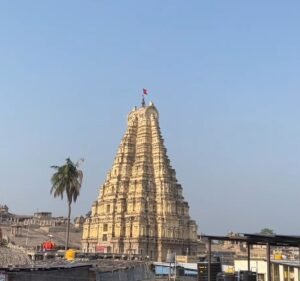
Hampi’s temples are not only ancient but also architecturally magnificent. Sites like the Virupaksha Temple and the Vithala Temple with its famous Stone Chariot attract tourists, historians, and photographers alike.
3. Landscape and Nature
Surrounded by Historic water canals, rivers, and vast plains, the unique landscape of Hampi creates an inspiring backdrop for the ancient remains. Whether you’re interested in history or nature, Hampi always offers the best.
About Hampi, Karnataka
Location: Google Maps
Hampi is located in the state of Karnataka, India, around 350 km from Bangalore.
Best Time to Visit:
October to February, when the weather is pleasant for exploring the ruins and temples without any hesitation of Sun.
Nearest Airport:
Hubli Airport is around 160 km away from Hampi.
Best Time to Visit Hampi
When thinking about how to plan a Hampi trip, one of the most important factors is choosing the right time to visit.
Best Time: October to February
The best time to visit Hampi is during the winter months, from October to February. This is the best time to visit with family. During this time, the weather is cool and perfect for sightseeing and outdoor activities.
This period is also great for trekking, cycling, and walking around the ruins without getting exhausted by the heat.
Please Avoid Summer: March to June
Hampi can get extremely hot in the summer, with temperatures often crossing 35°C. The heat can make it difficult to explore the monuments, many of which require walking and climbing. So if you planning to visit with your family then I suggest you avoid summer timings, it’s going to be difficult to explore with your family.
Monsoon Season: July to September
While the rains bring some relief from the heat, the monsoon season can make the paths slippery and dangerous. However, if you want to enjoy the lush green scenes, the monsoon can offer a different, quieter experience of Hampi.
How can you reach Hampi?
The next step is figuring out how to get there. Hampi is well-connected by air, train, and road.
By Air
The nearest airports to Hampi are:
Hubli Airport (165 km):
This is the closest airport to Hampi. You can take a taxi or bus from Hubli to Hampi.
Bangalore’s Kempegowda International Airport (350 km):
This is the major airport with more flight options, both domestic and international. From Bangalore, you can drive or take a train/bus to Hampi. Once you reach the airport, the journey to Hampi can be made by either bus or private taxi.
By Train
The nearest railway station to Hampi is Hospet Junction, located about 13 km from Hampi. Hospet is well-connected by trains from major cities like Bangalore, Hyderabad, and Goa.
From Hospet, you can hire an auto-rickshaw or take a local bus to reach Hampi.
Here are some popular train options:
From Bangalore: Hampi Express.
From Goa: Amaravathi Express.
By Road
Hampi is well-connected by road to nearby cities. KSRTC (Karnataka State Road Transport Corporation) operates several buses from Bangalore, Goa, Hyderabad, and Pune to Hospet. Once you reach Hospet, local transport will take you to Hampi.
If you prefer driving, here’s how long it takes to drive from:
Bangalore to Hampi: Approx. 6-7 hours (350 km)
Hyderabad to Hampi: Approx. 7-8 hours (380 km)
Goa to Hampi: Approx. 8 hours (310 km)
Where to Stay in Hampi?
Accommodation in Hampi ranges from budget guest houses to mid-range hotels, giving you a variety of choices based on your preferences and budget.
Hampi Bazaar Area
If you want to stay close to the ruins and temples, then the Hampi Bazaar area is ideal. This area has several guesthouses and budget accommodations, making it convenient to explore on foot.
Pros: Closer to major attractions, budget-friendly.
Cons: Basic facilities, may not have luxury options.
Virupapur Gaddi (Hippie Island)
Across the Tungabhadra River lies the laid-back Hippie Island, known for its relaxing atmosphere and beautiful views. This area is popular with backpackers and those looking for a more peaceful experience. You’ll find many eco-stays, guesthouses, and cafes in this area.
Pros: Beautiful surroundings, relaxed vibe.
Cons: Needs a boat ride to cross the river, fewer temples nearby.
Hospet
If you are looking for more comfort and amenities, Hospet is a great option. It’s a 15-minute drive from Hampi and offers mid-range and luxury hotels with modern amenities.
Pros: Better hotel options, and good connectivity to Hampi.
Cons: Slightly farther from the main attractions.
How to Cover Widely Spread Places in Hampi?
Exploring Hampi requires mobility, as the attractions are spread out across different parts of the city.
Here I suggest the best ways to get around:
Rent a Bicycle or Scooter
Many travellers opt to rent bicycles or scooters in Hampi, as it allows you to explore at your own pace. There are several rental shops in the Hampi Bazaar and Hippie Island area, offering these vehicles at affordable rates.
Bicycle: ₹150–₹200 per day
Scooter: ₹300–₹500 per day
Auto-Rickshaws
If cycling or riding a scooter is not for you, auto-rickshaws are readily available for hire. You can always negotiate a full-day rate with the driver, who will take you to all the major sites.
Cost: ₹700–₹1,500 for a full-day hire, depending on the distance and number of sites.
Walking
Hampi is a great place to explore on foot, especially if you’re only visiting the attractions near Hampi Bazaar. However, some of the sites are far apart, so walking may not be feasible for the entire trip.
Coracle Rides
To cross the Tungabhadra River, you can take a ride in a coracle (a round, traditional boat). Coracle rides are common between Hampi and Hippie Island, offering a fun way to travel across the river.
Places to visit in Hampi
1. Virupaksha Temple:
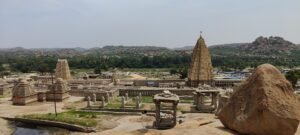
The Virupaksha Temple is one of the most iconic landmarks in Hampi. Dedicated to Lord Shiva, it is one of the oldest functioning temples in India, dating back to the 7th century. The temple’s architecture is a mixture of Dravidian and Vijayanagara styles, and its massive gopuram (gateway tower) rules over the skyline of Hampi.
Highlights:
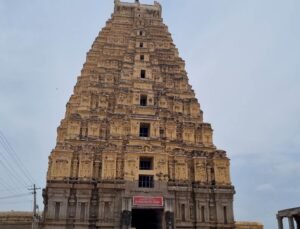
The Gopuram, standing at 50 meters tall, Inside, the sanctum houses a Shiva lingam, the primary deity of the temple. The temple complex also includes a marriage hall and several smaller shrines dedicated to other deities.
Don’t miss the Lakshmi elephant, who blesses visitors at the entrance.
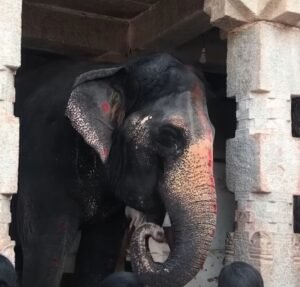
Best Time to Visit:
Early morning to avoid the crowds and heat.
2. Vitthal Swami Temple: The Jewel of Vijayanagara Architecture
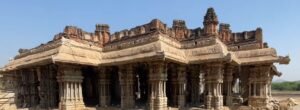
The Vittala Temple is perhaps the most famous monument in Hampi and is an outstanding example of the artistic brilliance of the Vijayanagara Empire. The temple complex is dedicated to Lord Vittala, an incarnation of Vishnu, and is famous for its stunning architecture and musical pillars.
Highlights:
The Stone Chariot:
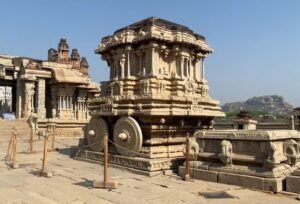
A life-sized chariot carved out of stone is one of the most photographed structures in Hampi. You can also find a photo of this chariot on a 50 rupees Indian note.
Musical Pillars:

The temple hall has 56 musical pillars that produce musical notes when tapped. The intricate carvings on the temple walls depict various scenes from Hindu mythology. The temple complex is vast, with multiple halls, shrines, and courtyards to explore.
Best Time to Visit:
Late afternoon to enjoy the cooler weather and catch the golden hour for photography.
3. Hampi Bazaar: A Journey Through Historical Market.

The Hampi Bazaar was once a busy marketplace during the Vijayanagara Empire, where merchants from all over the world traded goods. Today, the bazaar is a street lined with remains of old pavilions that were once shops.
Highlights:
The Bazaar Street stretches for nearly a kilometre, with rows of ancient stone structures on either side. You can explore the remains of old shops and pavilions, many of which still retain their original layout. At the end of the bazaar, you’ll find the Monolithic Nandi, a large stone sculpture of a bull, which is the vehicle of Lord Shiva.
Best Time to Visit:
Early morning or late afternoon to avoid the heat, as there’s little shade in the area.
4. Matanga Hill: The Best Viewpoint in Hampi

Matanga Hill is the highest point in Hampi and offers breathtaking panoramic views of the entire region. It’s a popular spot for watching the sunrise and sunset, as the hill provides complete views of the Hampi ruins and the surrounding landscape.
Highlights:
The hill is an easy-to-moderate trek and takes about 30-40 minutes to reach the summit. At the top, you’ll find the Veerabhadra Temple, a small shrine dedicated to Lord Shiva. The view from the top encompasses the Virupaksha Temple, the Hampi Bazaar, and the Tungabhadra River. Watching the sunrise or sunset from Matanga Hill is a must-do activity.
Best Time to Visit:
Early morning for the sunrise or late afternoon for the sunset.
5. Lotus Mahal: A Combination of Indo-Islamic Architecture
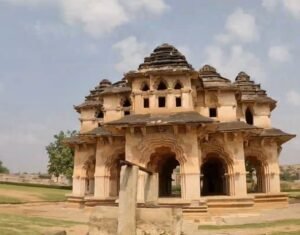
The Lotus Mahal is one of the most beautiful and well-preserved structures in Hampi, showcasing a mixture of Indo-Islamic architecture. The palace gets its name from its lotus-like design, with archways and domes that look like the petals of a lotus flower.
Highlights:
The symmetry and intricate carvings of the Lotus Mahal are the architectural brilliance of the Vijayanagara period. The palace was likely used as a recreational or meeting place for the royal women. The garden surrounding the Mahal adds to its serene ambience, making it a peaceful spot to relax after exploring the ruins.
Best Time to Visit:
Late afternoon, when the golden light enhances the beauty of the Mahal.
6. Royal Enclosure: The Heart of the Vijayanagara Empire
The Royal Enclosure was the epicentre of power during the reign of the Vijayanagara Empire. This vast complex includes the ruins of palaces, administrative buildings, and several tanks and water systems that were used by the royal officer.
Highlights:
Mahanavami Dibba:
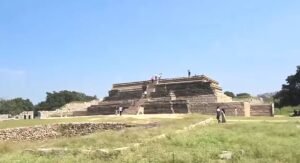
A massive platform was used by the kings for public celebrations, from where they would watch the annual Dasara festival.
Pushkarni:

An intricately designed water reservoir that served as a water storage system for the palace complex.
The Queen’s Bath:
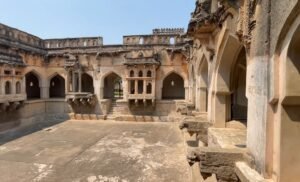
A large bath complex where the royal women would bathe. The structure is known for its Islamic-style arches and domes.
Best Time to Visit:
Morning or evening when the weather is cooler, as the enclosure is a large open area with limited shade.
7. Hazara Rama Temple: A personal Temple of the Royal Family carved into a single Stone
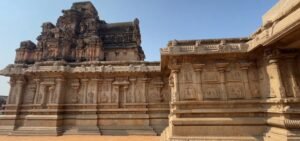
The Hazara Rama Temple is dedicated to Lord Rama and is known for its detailed carvings that depict the story of the Ramayana. The temple was used by the royal family and is located within the Royal Enclosure.
Highlights:
The temple walls are decorated with scenes from the Ramayana, carved in exquisite detail. The pillars inside the temple feature intricate designs, showcasing the artistry of the Vijayanagara Empire. The temple courtyard is a peaceful place to sit and reflect, offering a break from the larger, more crowded sites.
Best Time to Visit:
Early morning or late afternoon when the temple is less crowded.
8. Elephant Stables:
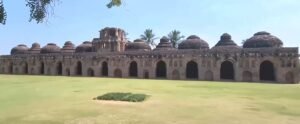
The Elephant Stables in Hampi are one of the most impressive structures in the city and were used to house the royal elephants. The building is a long rectangular structure with 11 domed chambers, each large enough to accommodate an elephant.
Highlights:
The Islamic-style domes and arches are a unique architectural feature not commonly seen in other parts of Hampi. The stables are well-preserved and give a sense of the rulers of the Vijayanagara Empire. Each dome is different in design, showcasing the creativity of the architects who built the structure.
Best Time to Visit:
Late afternoon, when the golden light brings out the details of the structure.
9. Hemakuta Hill: Famous for Temples and Stunning Views

Hemakuta Hill is located just a short walk from the Virupaksha Temple and is dotted with several small temples and shrines. The hill offers stunning views of Hampi’s remains and is a quieter spot compared to other more touristy areas.
Highlights:
The Hemakuta group of temples are relatively small and simple but offer a peaceful atmosphere for reflection and exploration. The view from the top of the hill provides a panoramic vista of the Hampi Bazaar, Virupaksha Temple, and the Tungabhadra River. You can catch the best sunrise or Sunset from this place.
Best Time to Visit:
Early morning for the sunrise or late afternoon for the sunset.
10. Anegundi:
Anegundi is a small village located across the Tungabhadra River from Hampi. It is often referred to as the cradle of the Vijayanagara Empire and offers a more peaceful and less touristy experience than the main Hampi area.
Highlights:
Ranganatha Temple:
A beautiful temple located in the heart of Anegundi village, dedicated to Lord Vishnu.
Pampa Sarovar:
A sacred lake also mentioned in the Ramayana, is believed to be the place where Lord Rama met Hanuman for the first time.
Anegundi Fort:
Explore the remains of the Anegundi Fort, which offers a glimpse into the region’s history before the rise of Vijayanagara.
Best Time to Visit:
Morning or evening to avoid the heat, especially if you’re planning to explore the fort.
11. Achyutaraya Temple: My Personal Favourite.
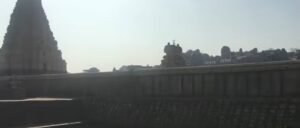
The Achyutaraya Temple is often overlooked by visitors but is one of the most architecturally stunning temples in Hampi. This is my favourite place in Hampi. The temple is located in the inhabitant’s area, making it a peaceful spot to explore.
Highlights:

The temple’s gopuram (entrance tower) and pillared halls are crafted with intricate carvings, showcasing the legacy of the Vijayanagara Empire. The temple complex is vast, with multiple courtyards, halls, and smaller shrines. Because it’s less crowded, you can explore the temple at your own pace, absorbing the peace and history.
Best Time to Visit:
Morning or late afternoon when the area is cooler and quieter.
12. Badavi Linga and Lakshmi Narasimha Statues: Magnificent Monoliths
These two massive monolithic structures are located near each other and are must-visit attractions in Hampi.
Badavi Linga:
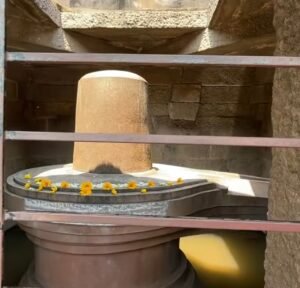
This is a 3-meter tall Shiva lingam, carved out of a single rock. The lingam is always submerged in water, symbolizing the presence of the river Ganges.
Lakshmi Narasimha Statue:
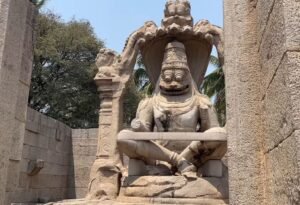
A tall statue of Lord Narasimha, the half-lion, half-human incarnation of Vishnu, seated in a fierce position. Originally, the statue included the figure of Goddess Lakshmi on Narasimha’s lap, but it was damaged during Islamic Sultanate invasions after 1565. i.e. After The Battle of Talikota.
Best Time to Visit:
Early morning or late afternoon to avoid the crowds and heat.
Creating Your Hampi Itinerary/ How To Plan A Hampi Trip?
Now comes the exciting part of how to plan a Hampi trip—building your itinerary. There are so many incredible sites to see, so having a clear plan will ensure you make the most of your time. Here I suggest the following plan for you. You can refer to it or you can create your own itinerary.
Day 1: Exploring the Sacred Centre
Start your journey by exploring Hampi’s Sacred Centre, which contains the most important religious and cultural sites.
Virupaksha Temple: This is the largest and most famous temple in Hampi, dedicated to Lord Shiva. The temple is known for its towering gopuram and ancient inscriptions.
Hampi Bazaar: Stroll through this ancient marketplace, once a thriving centre of trade during the Vijayanagara Empire.
Sasivekalu Ganesha and Kadalekalu Ganesha:
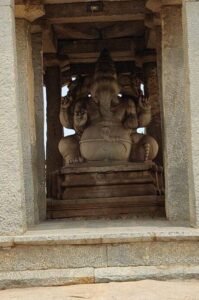
Visit these two giant statues of Lord Ganesha, each carved out of a single stone.
Hemakuta Hill: This hill offers a panoramic view of Hampi and is a great spot for watching the sunset.
Monolithic Bull (Nandi): Located at the eastern end of Hampi Bazaar, this large statue of Nandi (the bull mount of Lord Shiva) is a popular site for tourists.
Day 2: The Royal Centre and Riverside Remains.
The second day should focus on Hampi’s Royal Centre, where you can explore the architectural beauty of the Vijayanagara Empire.
Queen’s Bath: A beautiful Indo-Islamic structure, this royal bath was once used by the queens of Vijayanagara.
Lotus Mahal: Known for its delicate arches and lotus-shaped dome, this is one of the best-preserved buildings in Hampi.
Hazara Rama Temple: Famous for its intricate carvings depicting scenes from the Ramayana, this temple is a must-visit.
Elephant Stables: Visit these 11 large domed chambers where royal elephants were once housed.
Vithala Temple: End your day with a visit to the iconic Vithala Temple, famous for its Stone Chariot and musical pillars.
Day 3: Offbeat Hampi and Adventure
For the third day, we are going beyond the major remains to explore the hidden gems and outdoor activities Hampi has to offer.
Matanga Hill:
Trek to the top of Matanga Hill for a breathtaking view of Hampi and its surrounding landscape. This hill is considered one of the best spots for sunrise and sunset in Hampi. The trek is relatively easy and takes about 30-40 minutes to reach the summit.
Anegundi Village:
Located across the Tungabhadra River, Anegundi is an ancient village often referred to as the cradle of the Vijayanagara Empire. The village has several temples and historical sites, offering a more peaceful alternative to the tourist-heavy Hampi Bazaar area.
Here I am going to suggest some offbeat places that aren’t mentioned above the discussion of places
Sanapur Lake:

If you’re looking for a more relaxed experience after exploring the ruins, head to Sanapur Lake. This serene lake, surrounded by boulders, is perfect for a coracle ride or a quick dip (though swimming isn’t recommended due to safety concerns). The lake is also a great spot for photography.
Tungabhadra Dam:

About 20 km from Hampi, the Tungabhadra Dam offers a scenic landscape and a peaceful retreat. It’s an ideal place for a picnic and a pleasant way to wind down after exploring the remains.
Local Food and Where to Eat in Hampi
Food is an important part of any travel experience, and Hampi offers a range of options for different tastes and budgets. Here’s what you can expect in terms of local food and where to eat
Some must-try dishes include:
Dosa: A South Indian staple, dosa is a thin, crispy pancake served with coconut chutney and sambar.
Idli: Soft, steamed rice cakes that make for a light and healthy breakfast.
Bisi Bele Bath: A popular Karnataka dish made with rice, lentils, and a blend of spices, perfect for lunch or dinner.
Lassi: A refreshing yoghurt-based drink, perfect to cool off after a day of sightseeing.
Here I Suggest Some Popular Restaurants and Cafes
Mango Tree Restaurant:
One of the most popular restaurants in Hampi, Mango Tree offers a variety of dishes, including South Indian thalis, North Indian curries, and Western food.
Gopi Guesthouse and Restaurant:
Known for its rooftop dining experience, Gopi Restaurant offers a mix of Indian and continental dishes.
Laughing Buddha Cafe:
Located on Hippie Island, this cafe has a relaxed vibe and serves a variety of international dishes, including pizzas, pasta, and sandwiches.
Suresh Restaurant:
A budget-friendly option near the Hampi Bazaar, Suresh Restaurant is known for its South Indian thali and simple vegetarian meals.
Shopping in Hampi!!
Though Hampi isn’t primarily a shopping destination, there are a few places where you can pick up unique things, handicrafts, and textile products
Hampi Bazaar
The Hampi Bazaar is the go-to place for tourists looking to buy something. Here you can find a variety of items such as:
Handicrafts:
Look for traditional Karnataka handicrafts, including wooden toys and carved stone artefacts.
Jewellery:
Silver and beaded jewellery are popular among tourists, especially at the stalls near the Virupaksha Temple.
Bags and Textiles:
You’ll find handmade cotton bags, pouches, and colourful textiles perfect for gifting or personal use.
Anegundi Village
Here I am suggesting you visit Anegundi Village, you’ll find local artisans selling unique crafts, including pottery, woven baskets, and traditional artwork. The village’s crafts are more authentic and less touristy compared to the Hampi Bazaar.
Things you should keep in Mind While Visiting Hampi
To ensure a smooth and enjoyable trip, here are some important tips to consider while planning your visit to Hampi:
1. Dress Modestly
Since many of the attractions in Hampi are religious sites, it’s important to dress modestly. Ensure your shoulders and knees are covered, special care should be taken while visiting temples.
2. Carry Some Cash
While there are a few ATMs in Hampi, they may not always be reliable. UPI payment acceptance is also limited so I advise you to carry enough cash, especially for smaller expenses like food, transportation, and entry fees to the monuments.
3. Stay Hydrated
The weather in Hampi can get quite hot, especially if you’re visiting outside in the winter months. Make sure to carry enough water and stay hydrated throughout the day.
4. Wear Comfortable Footwear
You’ll be walking a lot in Hampi, whether it’s through the remains, up the hills, or around the bazaars. Make sure to wear comfortable footwear, preferably closed-toed shoes for climbing rocky terrain.
Some Suggestions For Your Packing
Packing for a trip to Hampi requires a mix of essentials that will help you navigate the heat, terrain, and temples comfortably. Here’s I suggested packing list for your convenience:
Clothing
Light cotton clothes:
Comfortable clothing is a must, especially if you’re visiting during the warmer months.
Modest dressing:
Ensure your clothing covers your shoulders and knees, especially when visiting temples.
Hat and sunglasses:
Essential for protecting yourself from the sun while exploring outdoors, especially in summer.
Sturdy shoes:
Comfortable walking shoes are a must for navigating the rocky terrain and ruins.
Essentials Water bottle:
Stay hydrated, especially while walking long distances.
Sunscreen:
The sun can be harsh, so protect your skin with sunscreen.
Power bank:
Ensure your phone stays charged for navigation and photography.
Camera:
Hampi offers incredible photo opportunities, so don’t forget your camera or smartphone with plenty of storage.
Miscellaneous
ID Proof: Always carry a government-issued ID for hotel check-ins and ticket bookings.
Guidebook or Map: If you prefer offline navigation, having a map or guidebook of Hampi can be helpful.
Conclusion:
Visiting Hampi is like stepping back in time to a place where history, architecture, and nature coexist. From its grand temples to the landscape, there’s something in Hampi for every type of traveller.
By following this guide on how to plan a Hampi trip, you can ensure a smooth, enjoyable, and fulfilling journey. Whether you’re a history lover, a backpacker, or a nature lover, Hampi promises an unforgettable experience.
Remember to be mindful of the weather, plan your transportation and accommodation ahead of time, and leave enough room in your itinerary to explore the hidden gems and offbeat paths of this incredible destination. Safe travels! And Happy Journey!!!
Also Read: Top 10 Places To Visit In Ooty.

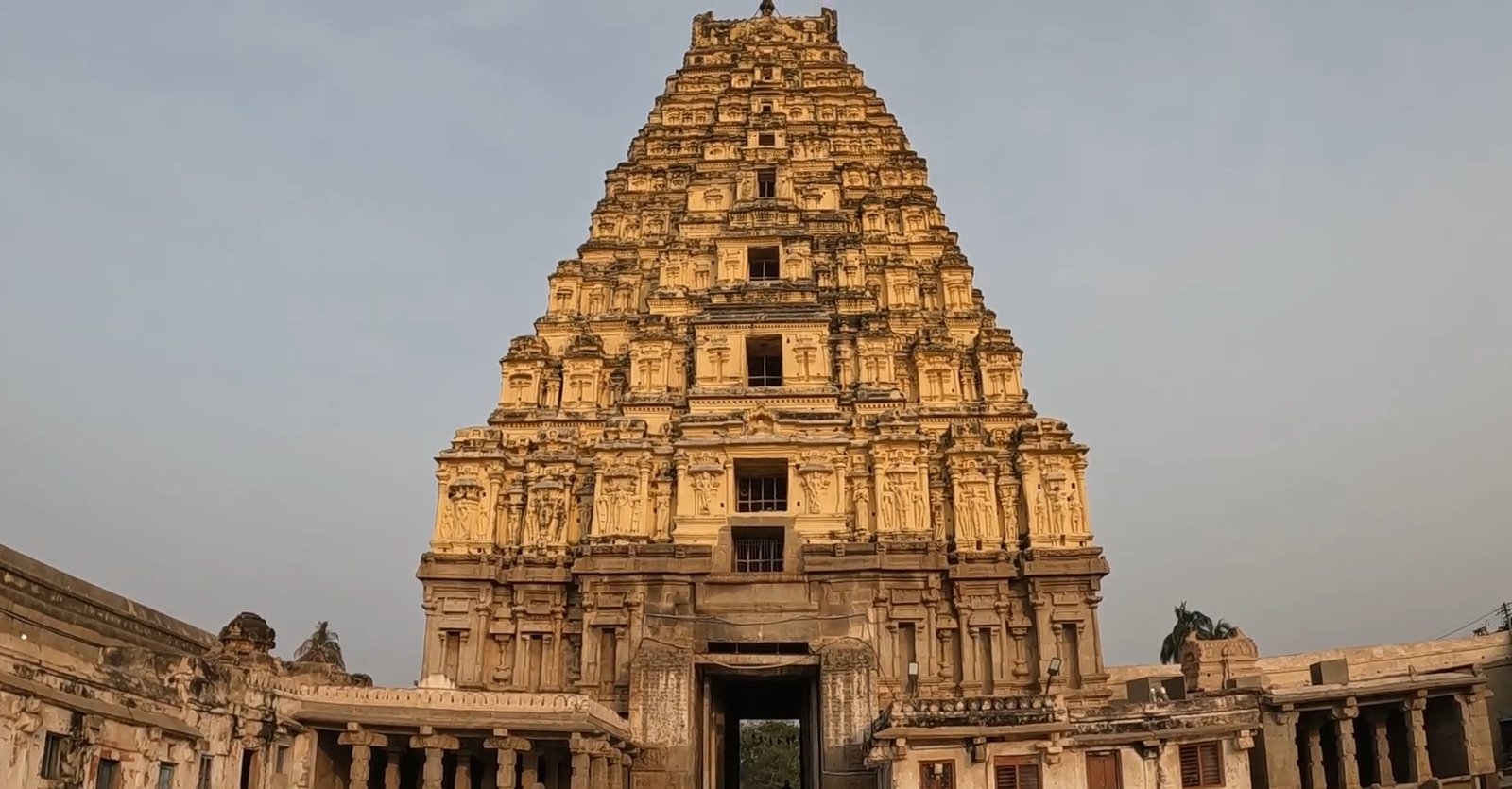
5 thoughts on “How To Plan A Hampi Trip”